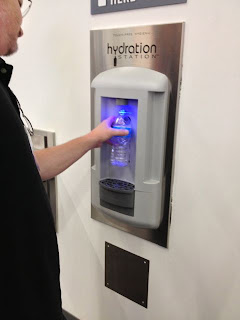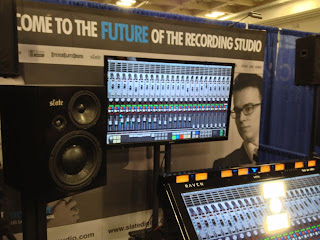
Conventions/exhibitions in the musical instrument and audio space have been a bit of a bummer lately in that there are no surprises or must-see items any more. The
Audio Engineering Society's 133rd convention at the
Moscone Center in San Francisco proved to be a bit different in that respect because finally there was a product that had the whole show talking. Before we get to that, here are a few generalities about the show.
In General
AES is supposed to be the biggest audio show in the land, yet it was missing at least three highly influential manufacturers this year: Avid (Pro Tools), Manley and Universal Audio. This is an on-going trend where many manufacturers now believe that AES is no longer the must-not-miss sales opportunity that it once was. Exhibiting at AES is expensive, especially in San Francisco, and the fact of the matter is that the San Fran show feels pretty local as people don't fly in from around the world for the show like they once did.
As a result, we're seeing the incredible shrinking show, as it was a lot smaller than in recent years. Of the booths that were there, most were considerably downsized from the show's peak, and there were a lot of empty spaces where a manufacturer didn't bother to show. Where once upon a time there were demo rooms everywhere, this year there might have been only enough to count on one hand.
That said, the attendance was pretty good, with traffic on Friday for the presentations beyond my expectations, and pretty strong on Saturday as well. Not only that, the vibe was particularly good. People in the business are making money, although everyone seems to agree that they work a lot harder for a little less than they were used to before. That's now the norm.
Another thing about AES this year that's been similar to other recent shows is the overabundance of new boutique speaker, microphone and mic preamp/compressor manufacturers. These companies spring up like crazy, each with the idea that they can somehow reinvent the wheel (for speaker manufacturers) or that the world somehow needs a new version of a
U47,
Neve mic pre, or
Fairchild compressor. What's even crazier is that many spend big dollars to exhibit so they can just show a prototype that they can't even ship. I just can't believe that the marketplace is big enough for that many also-rans with that little business sense (sorry to be so harsh, but someone has to say it).
 |
| Moscone Water Refill Station |
Say what you want about the show, the Moscone Center is a pretty good place for a convention for an attendee. The free Wifi was very much appreciated, and the filtered water refill station were great.
Social Media For Musicians And Engineers
On Friday I gave a presentation that's become quite popular at colleges around the country regarding social media and how the musician, engineer, producer or musician can use it as a promotional tool. Even though my session was up against one across the hall with the legendary Al Schmitt, it was still very well attended, as we went through two hours of Facebook, Twitter, YouTube, website and email newsletter promotional tips and tricks.
Every time I give this presentation I'm always surprised at some of the answers that I get when I ask the question, "Have you seen this site (or app) before?" as I mention what seems to be a well-known online tool. Even in the heart of the hippest technical community in the world, many of the online promotional technology tools are still not fully understood by many of the attendees, or they're not even aware of them. It's something I see all over the world though, so nothing new here.
The surprising part is that if you listen to the media, every kid and young adult from 13 to 30 is a computer whiz and knows about everything that happens online. That's far from the truth though. We're all in this together, regardless what your age is, as we all learn as we go along. That's one of the reasons I love doing this presentation. I'm really pleased that people seem to get so much from it (or so they tell me).
The Big Hit
By far the biggest hit of not only this show but in recent memory is the Raven MTX production console by Slate Audio. There was a buzz on the floor everywhere you went about it, and when you did finally see it, there was always a crowd about 5 or 6 deep around it. Here's what was revealed while I was at the demo.
 |
| Raven Mix Window |
The Raven is basically a big controller for
Pro Tools (for now) and other DAWs that supplies it's own monitor section based upon the outputs from your D/A convertor. If you have enough outputs, it can configure to a 7.1 monitor complete with up to 5 headphone sends and more.
The massive 46 inch touchscreen is custom designed so that you can work for long hours looking at it from a short distance, and the angle was precisely calculated by a ergonomics consultant. Everyone who looks at it seems to thing that the angle is somehow off, but it seems about right when you sit behind it in that you can easily touch everything you have to pretty easily; much easier than a traditional console in fact. The screen is large so that a plugin is the size of a normal 19 inch rack hardware device, which means that the controls are about the same size as the knobs would be. The screen is also infrared controlled rather than capacitive like most touch screens, mostly because there wasn't a touchscreen that large easily available. That said, I spoke with someone who used it for a second who said that the movement of the onscreen controls didn't feel all that precise.
 |
| Raven Extension Monitor |
But that may be a moot point. The unit at the show was only a prototype, which is why the frame looked a little cheesy. That's also why they didn't have a price yet. It's just too early in the development cycle to know, although software-wise everything seemed to work just fine. As a mixer, it looked and worked great, as it did in the standard Pro Tools edit window.
There are a lot of other nice features too. An built-in iPhone dock, top-mounted USB ports for flash drives, dongles and hard drives, and multiple talkback buttons. You can tell it's built by a console user rather than an electronics engineer.
 |
| The Raven Edit Window |
I wasn't too happy that my questions where either blown off or treated dismissively, but I'll chalk that up to show fatigue for now (although it was pretty early on the first day). Maybe my questions where pretty basic (like "How much does it cost?"), but that's no reason to be disrespectful to anyone.
All that aside, I think this might be a hit if the price isn't too outrageous. The Raven might be that missing piece in the studio between some of the smaller dedicated controllers and the large analog consoles that we so love.
Tomorrow, some other cools stuff I spotted in Part 2.
----------------------------------





























